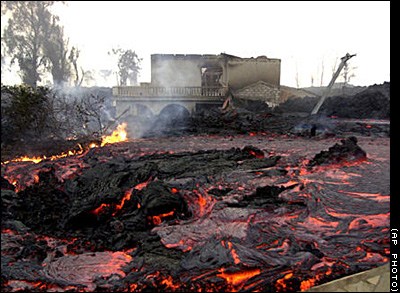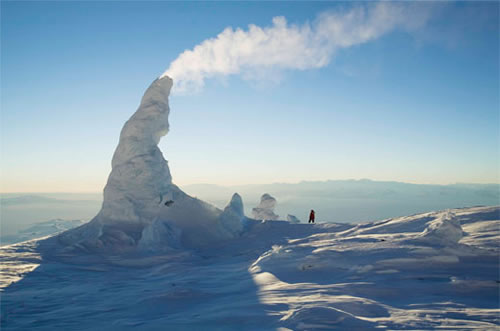I am sure everyone is aware of the varying impacts of hazards around the world (Millie has written a very interesting post comparing recovery after the Christchurch, Great Honshu and Haiti earthquakes - it is worth checking out!) and volcanic hazards are no different. Much of this variation is dictated by degree of development but it is important to note that, due to our ability to predict them, no one anywhere in the world should really die as a direct consequence of an eruption. Instead it is the secondary impacts that cause the most problems.
Gas
- All volcanic eruptions are caused by gas escaping from magma with the viscosity of magma determing the ease at which gases escape
- High viscosity = explosive eruption with pyroclastics
- Low viscosity = effusive fumaroles with fire fountains and lava
- Active volcanoes produce large volumes of water vapour, carbon dioxide, chlorine, hydrogen sulphide, hydrogen, helium, hydrogen monoxide, hydrogen chloride, amongst other nasty gases. Fortunately they rarely reach lethal levels in populated areas but as carbon dioxide is denser than air it can collect in depressions which allow concentrations to build up to a level capable of suffocation.
- Lake Nyos, 1986, is the only example of gas killing people.

- August 21st, 1986, limnic eruption occured, triggering sudden release of 1.6 billion tonnes of carbon dioxide. As carbon dioxide is 1.5 times more dense than air, the cloud suffocated some 1,700 people within 20km of the lake and 3,500 livestock. A further 4,000 people fled the area, with many developing health problems a as result of exposure to this hazard.
--> Degassing the lakes is a form of managment as by capturing the gas the risk is minimised. Important to note that 1986 was the first limnic eruption we have known to occur as there is no record of past eruptions. Therefore we were unaware that such a hazard existed. Now, degassing columns have been placed into the lake. The same has been done with Lake Kivu which contains methane. The difference here is that the degassed methane is beign used to run powerstations to provide electricity, aiding development.
Lava Flows

- Only basaltic lavas are 'runny' enough to travel far from their source. Although all lavas slow as they start to cool, basaltic lavas often destroy property but rarely kill people as flows are predictable
- Nyiragongo is the only example where people have died - in 1977, 70 people were killed. Most recent eruption was 2002 when 300,000 people were forced to flee into neighbouring Rwanda and 15% of Goma was consumed.
--> Management is possible as was seen during the 1973 eruption of Heimaey (Iceland) and Etna. In both cases the lava flows were diverted away from populated areas.
Pyroclastic Flows
- Mixture of rock, gas, magma blasted out of composite volcanoes.
- Viscous lavas
- Travel at over 300mph with inner temperatures of 500C
- Deadly killers as can affect up to 40km from the vent, travelling in all directions
- Examples = Mount St Helens, Pinatubo and Unzen
--> Only management is effective evacuation, which is reliant on good prediction, as nothing can really stop a pyroclastic flow
Lahars

- Can be set off by the eruption by the melting of a summit glacier - e.g Nevado del Ruiz and Iceland (jokulhlaup)
- Or caused by rain mixing with ash and causing massive continuous flooding - e.g PInatubo, although eruption was last in 1991, a tropical cyclone passed over the area last year provoking a lahar
Landslides
- Landlisdes set off by the eruption can cause destruction
- Mount St Helens eruption was caused by a landslide
- Landslides also can cause tsunamis on islands and coastal volcanoes i.e Stromboli and Krakotoa
Ash
- Ash causes total destruction for hundreds of square kilometres
- Building collapse is most common cause of death due to volcanic hazards
- Destroys land and kills animals. Contaminates water supplies and sets like concrete with rain
- Can cause global cooling and reduce rate of sea level rise - e.g Pinatubo cooled world temperatures by 1C for 5 years
- Economic impacts with disruption to air travel - e.g Iceland E-15 eruption
Good Managment Case Studies
- Lava flows of basaltic eruptions = Etna and Heimaey
- Channelling of lahars = Japan
- Prediction success = Pinatubo, Unzen and Montserrat
- Prediction failure = Nevado del Ruiz, Mount St Helens
As with any hazard management can be split into several catergories:
- Prediction - now very advance with volcanoes
- Hazard mapping i.e of past eruptions
- Monitoring - many of the worlds volcanoes, especially those near densely populated areas, are monitored
- Evacuation plans and procedures
- Education
- Hard engineering management such as lava flow diversion
Key Points:
- The variation of impacts is controlled by the type of volcanic eruption (therefore in an essay on hazards you could slip in some of your knowledge on silica content etc.)
- Further variation is provoked by degree of development
- If we knew were the volcanoes were it is unlikely we would have settled there! However, the offerded fertile lands to earlier settlers and since then many have grown into densely populated cities. It is unlikely that we will just move the cities away from the hazard (will be interesting to see what decision is made with Christchurch though!) and as population continues to expand more people will come into contact with the risk. Therefore there is an increasing need for management.
REMEMBER:- A hazard does not necessarily put you at risk.....
Hazard = the way in which an object or situation may cause you harm
Risk = the chance that harm will occur
Disasters only occur when people come into close contact with a hazard, hence why the risk will increase as global population expands and more are forced onto marginal lands.
- Nowadays people shouldn't really die directly from volcanic hazards due to our ability to predict them, but people do - why?
 ---> Not all magma makes it to the surface to be extruded, some of it solidifies underground. The igneous rocks formed can contribute to surface geomorphology through uplift, erosion and exposure at the surface.
---> Not all magma makes it to the surface to be extruded, some of it solidifies underground. The igneous rocks formed can contribute to surface geomorphology through uplift, erosion and exposure at the surface. 

 - Quite a lot of castles are built on old igneous intrusive landforms such as volcanic plugs
- Quite a lot of castles are built on old igneous intrusive landforms such as volcanic plugs GIANTS CAUSEWAY/FINGALS CAVE
GIANTS CAUSEWAY/FINGALS CAVE


























